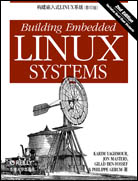
构建嵌入式LINUX 系统(第二版,影印版)
出版时间:2009年04月
页数:439
虽然很多公司将Linux用于多种嵌入式系统,从手机到汽车ABS系统和水过滤设备,但令人惊讶的是,关于Linux系统内核和相关工具的建立、安装、测试方面信息的资源几乎没有。
《构建嵌入式Linux系统》是一本构造这些系统的详细指南。你不仅可以学习基本原理,而且可以学习如何去配置、设置并使用40种以上不同的开源和自由软件包。
此次再版更新了上一个版本的Linux系统内核,展示了之前未公开的程序,以助你:
* 建立自己的GNU开发工具链
* 选择、配置、构建并安装特定目标的内核
* 创建完整的目标根文件系统
* 设置、操作及使用固态存储设备
* 安装并配置目标的引导加载程序
* 交叉编译大量实用程序和包
* 使用多种工具和技术调试嵌入式系统
* 使用uClibc、BusyBox、U-Boot、OpenSSH、thttpd、tftp、 strace和gdb包
* 以Xenomai或RT内核补丁充分发挥实时功能
此次再版教授了如何构建操作系统组件,简化了令人望而生畏的维护嵌入式系统的完全控制的任务。
“这本书中没有关于常用工具或项目范围的任何假设。所需要的……就是下载必要包和浏览详尽在线文档的Internet连接,从而与其他开发者互享经验并从中获益。
这些讲述不仅在设计上给予恰到好处的自由及控制,也紧随Linux嵌入式系统应用的开发先锋们的观点。”
——节自Preface
《构建嵌入式Linux系统》是一本构造这些系统的详细指南。你不仅可以学习基本原理,而且可以学习如何去配置、设置并使用40种以上不同的开源和自由软件包。
此次再版更新了上一个版本的Linux系统内核,展示了之前未公开的程序,以助你:
* 建立自己的GNU开发工具链
* 选择、配置、构建并安装特定目标的内核
* 创建完整的目标根文件系统
* 设置、操作及使用固态存储设备
* 安装并配置目标的引导加载程序
* 交叉编译大量实用程序和包
* 使用多种工具和技术调试嵌入式系统
* 使用uClibc、BusyBox、U-Boot、OpenSSH、thttpd、tftp、 strace和gdb包
* 以Xenomai或RT内核补丁充分发挥实时功能
此次再版教授了如何构建操作系统组件,简化了令人望而生畏的维护嵌入式系统的完全控制的任务。
“这本书中没有关于常用工具或项目范围的任何假设。所需要的……就是下载必要包和浏览详尽在线文档的Internet连接,从而与其他开发者互享经验并从中获益。
这些讲述不仅在设计上给予恰到好处的自由及控制,也紧随Linux嵌入式系统应用的开发先锋们的观点。”
——节自Preface
- Preface
- 1. Introduction
- Definitions
- Real Life and Embedded Linux Systems
- Design and Implementation Methodology
- 2. Basic Concepts
- Types of Hosts
- Types of Host/Target Development Setups
- Types of Host/Target Debug Setups
- Generic Architecture of an Embedded Linux System
- System Startup
- Types of Boot Configurations
- System Memory Layout
- 3. Hardware Support
- Processor Architectures
- Buses and Interfaces
- I/O
- Storage
- General-Purpose Networking
- Industrial-Grade Networking
- System Monitoring
- 4. Development Tools
- A Practical Project Workspace
- GNU Cross-Platform Development Toolchain
- C Library Alternatives
- Java
- Perl
- Python
- Other Programming Languages
- Eclipse: An Integrated Development Environment
- Terminal Emulators
- 5. Kernel Considerations
- Selecting a Kernel
- Configuring the Kernel
- Compiling the Kernel
- Installing the Kernel
- In the Field
- 6. Root Filesystem Content
- Basic Root Filesystem Structure
- Libraries
- Kernel Modules
- Kernel Images
- Device Files
- Main System Applications
- Custom Applications
- System Initialization
- 7. Storage Device Manipulation
- MTD-Supported Devices
- Disk Devices
- To Swap or Not To Swap
- 8. Root Filesystem Setup
- Filesystem Types for Embedded Devices
- Writing a Filesystem Image to Flash Using an NFS-Mounted Root Filesystem
- Placing a Disk Filesystem on a RAM Disk
- Rootfs and Initramfs
- Choosing a Filesystem’s Type and Layout
- Handling Software Upgrades
- 9. Setting Up the Bootloader
- Embedded Bootloaders
- Server Setup for Network Boot
- Using the U-Boot Bootloader
- 10. Setting Up Networking Services
- Network Settings
- Busybox
- Dynamic Configuration Through DHCP
- The Internet Super-Server
- Remote Administration with SNMP
- Network Login Through Telnet
- Secure Communication with SSH
- Serving Web Content Through HTTP
- Provisioning
- 11. Debugging Tools
- Eclipse
- Debugging Applications with gdb
- Tracing
- Performance Analysis
- Memory Debugging
- A Word on Hardware Tools
- 12. Introduction to Real-Time Linux
- What Is Real-Time Processing?
- Should Your Linux Be Real-Time?
- Common Real-Time Kernel Requirements
- Some Typical Users of Real-Time Computing Technology
- The Linux Paths to Real-Time
- 13. The Xenomai Real-Time System
- Porting Traditional RTOS Applications to Linux
- The Xenomai Architecture
- How Xenomai Works
- The Real-Time Driver Model
- Xenomai, Chameleon by Design
- 14. The RT Patch
- Interrupts As Threads
- Priority Inheritance
- Configuring the Kernel with the RT Patch
- High-Resolution Timers
- The Latency Tracer
- Conclusion
- Index
书名:构建嵌入式LINUX 系统(第二版,影印版)
国内出版社:东南大学出版社
出版时间:2009年04月
页数:439
书号:978-7-5641-1630-9
原版书出版商:O'Reilly Media
The cover image is a 19th-century engraving from the Dover Pictorial Archive.
购买选项